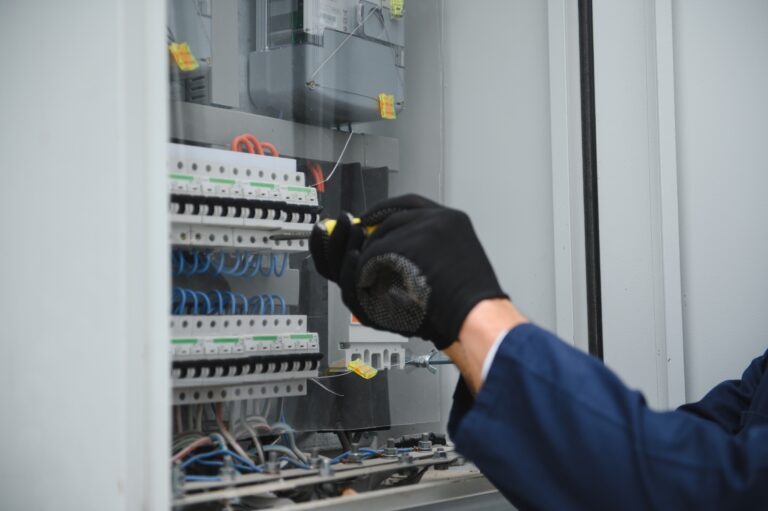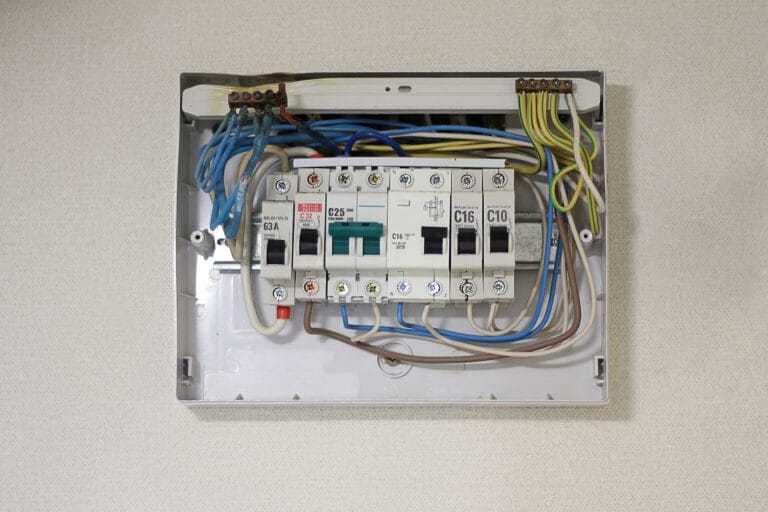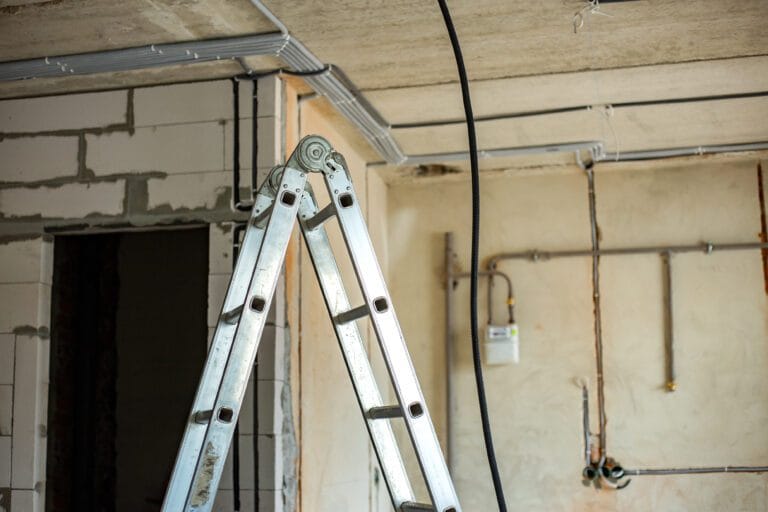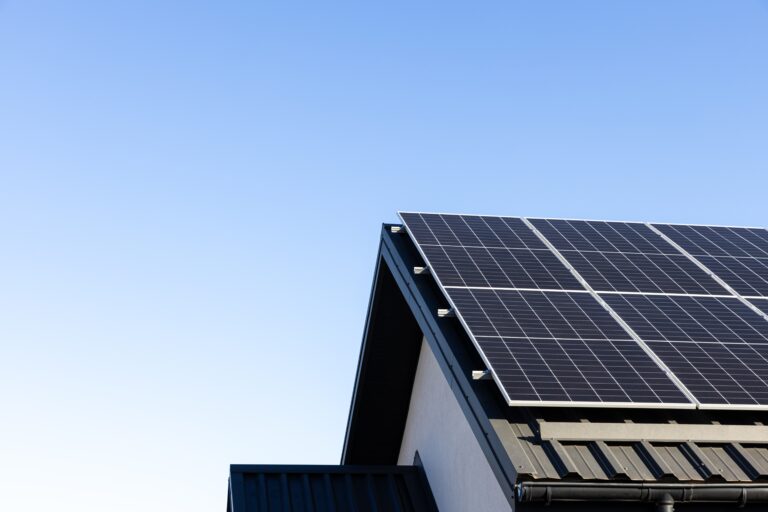5 Warning Signs Your Home’s Wiring is Unsafe
Keeping your home’s electrical wiring in top shape is crucial. Faulty wiring can lead to severe dangers, including electrical fires and shocks, compromising the safety of your family and property. Identifying warning signs of unsafe wiring can prevent potential disasters and ensure peace of mind. This article highlights five key indicators that should prompt immediate attention from a professional electrician, whether you need a residential electrician or a commercial electrician.
Recognizing these signs early helps maintain a safe environment and protects your investment in home electrical wiring. Here are five warning signs to watch out for:
- Frequent Circuit Breaker Trips: If your circuit breaker trips frequently, it may be a sign of an overloaded circuit or a short circuit. This issue requires immediate attention from a professional electrician.
- Flickering or Dimming Lights: Flickering or dimming lights can indicate poor wiring connections or insufficient power supply. These issues should not be ignored as they can lead to more severe problems.
- Burning Smell or Scorch Marks: A burning smell near outlets or switches, or scorch marks on your walls, are serious warning signs of electrical problems. These could potentially lead to electrical fires if not addressed promptly.
- Old or Outdated Wiring: If your home has old wiring that hasn’t been updated in years, it may not be equipped to handle the power demands of modern appliances. In such cases, it’s advisable to consider an electrical upgrade.
- Unusual Sounds from Electrical Outlets: If you hear buzzing or crackling sounds coming from electrical outlets, it’s a clear sign that something is wrong with your wiring.
If you notice any of these warning signs, it’s essential to contact a professional electrician immediately for an inspection and necessary repairs. You can reach out for assistance through our contact page. Remember, staying informed about these warning signs can help maintain a safe environment for you and your family while protecting your investment in home electrical wiring. Stay informed, stay safe!
Warning Signs of Unsafe Electrical Wiring You Shouldn’t Ignore
1. Frequent Tripping of Circuit Breakers or Blown Fuses
Frequent tripping of circuit breakers or encountering blown fuses isn’t just an inconvenience; it’s a common warning sign that your home’s electrical system might be unsafe. When a circuit breaker trips, it disconnects power to prevent wires from becoming overheated and causing further damage or fire hazards. This protective measure is crucial, but if it happens regularly, it indicates an underlying issue.
Several factors can trigger this frequent tripping:
- Overloaded Circuits: Plugging in too many appliances on one circuit can exceed its capacity.
- Short Circuits: Occurs when the hot wire touches a neutral wire, creating a surge of electricity.
- Ground Faults: Similar to short circuits but involves the hot wire coming into contact with a ground wire.
These occurrences often signify that your home’s wiring is outdated or insufficient for your current needs. In places like Melbourne, where older homes are common, outdated electrical systems can struggle to handle the demands of modern appliances. This not only affects your convenience but also poses significant safety risks.
Ignoring these signs could lead to more severe problems such as electrical fires. A proactive approach involves seeking professional help for home rewiring in Melbourne. Ensuring your electrical wiring meets current safety standards is essential for protecting your home and loved ones.
Regular inspections by qualified electricians can identify these issues early, allowing you to address them before they escalate into costly repairs or dangerous situations. Recognizing these unsafe electrical systems ensures peace of mind and enhances the safety of your living environment.
2. Outdated Switchboards
An outdated switchboard can also contribute to electrical hazards in your home. If your switchboard frequently trips or shows signs of wear and tear, it might be time for an upgrade. Modern switchboards are designed to handle higher loads and come with better safety features.
3. Lack of Smoke Alarms
Another critical aspect of home safety is the presence of functional smoke alarms. If you notice that your smoke alarms are either non-existent or not working properly, it’s essential to address this issue immediately. Professional electricians can assist in installing smoke alarms that comply with safety standards and provide reliable protection against fire hazards.
4. Insufficient Security Measures
In addition to ensuring electrical safety, it’s also vital to secure your home against potential intruders. This includes having a robust security system in place. If you’re considering enhancing your home’s security, data cabling for security cameras can be an effective solution. These cameras not only deter potential burglars but also provide valuable evidence in case of a break-in.
Recognizing these warning signs and taking immediate action can significantly improve the safety and security of your home. Always consult with professionals who have the expertise and experience to handle these issues effectively.
2. Dimming or Flickering Lights
When your lights start flickering or dimming unexpectedly, it’s more than just annoying; it could be a warning sign of potentially unsafe electrical systems. This often indicates problems with your home’s wiring that could become serious hazards if not fixed quickly.
Common Causes of Flickering Lights:
- Loose Connections: Poorly connected wires can lead to inconsistent power flow, causing lights to flicker.
- Overloaded Circuits: Too many devices drawing power from the same circuit can result in lights dimming as the system struggles to cope.
- Switching on High-Power Appliances: Appliances like air conditioners or refrigerators may cause temporary dips in lighting when they turn on.
The importance of flickering lights should not be ignored. They often indicate outdated or overloaded electrical systems—especially in older homes that haven’t had home rewiring done in recent years. Recognizing these signs early is crucial to prevent potential hazards and ensures your home remains safe and compliant with current standards. If you notice persistent flickering lights, consider consulting professionals specializing in electrical wiring for a thorough evaluation.
3. Hot or Discolored Switch Plates and Cords
It’s important to know the warning signs of unsafe electrical systems to keep your home safe. One sign to look out for is hot switch plates or discolored cords. These could mean that there’s something wrong with your wiring.
Dangers of Hot Switch Plates and Cords
When switch plates feel hot when you touch them, it usually means that too much current is flowing through the wires. This can cause circuit breakers to trip or even fuses to blow, leading to a scenario where you need to learn how to deal with tripped circuit breakers and blown fuses as a temporary fix. Over time, this excessive heat can damage the insulation on the wires, creating a serious fire hazard.
Indicators of Faulty Wiring
If you notice any discoloration on your cords or switch plates, it usually means that they’re overheating. This could be due to old wiring systems or circuits that are struggling to handle heavy loads. In areas like Melbourne, where many homes are older, it’s crucial to spot these signs early on to avoid dangerous situations.
Knowing these signs is vital for any homeowner thinking about rewiring their home in Melbourne. By being aware of these indicators, you can take action quickly and protect both your property and the people living in it.
4. Loose Power Outlets
Loose power outlets are a common warning sign of unsafe electrical systems that should never be overlooked. These wobbly outlets can pose serious risks, including electric shocks and potential fire hazards, making it crucial to address them promptly.
Risks of Loose Power Outlets
- Electric Shocks: A loose outlet may cause wires to become exposed or disconnected, increasing the likelihood of electrical shocks when plugging or unplugging devices.
- Fire Hazards: Over time, a loose connection can cause arcing—a phenomenon where electricity jumps between connections—which can generate excessive heat and potentially ignite nearby materials.
Maintaining secure connections is crucial for outlet safety. Regular inspection and prompt repair by professionals specializing in electrical wiring in Melbourne ensure your home stays safe. This proactive approach also helps prevent more severe issues such as tripping circuit breakers or blown fuses, which are often symptoms of underlying electrical problems. Recognizing these signs early is key to avoiding significant hazards and costly repairs.
5. Unusual Noises from Electrical Systems
Unusual noises in your electrical system are common warning signs indicating potential dangers. These sounds, often described as buzzing noises or sizzling sounds, suggest issues like loose connections or faulty wiring. Unsafe electrical systems can manifest through these auditory cues, pointing to underlying problems that require immediate attention.
Ignoring these noises poses serious risks. If left unaddressed, they may lead to:
- Electrical Fires: Faulty wiring can overheat, sparking fires that endanger property and lives.
- Power Outages: Persistent issues could cause tripping circuit breakers or blown fuses, leading to inconvenient and potentially damaging power loss.
Identifying such key indicators early is crucial for preventing hazards. Regular maintenance and prompt intervention by professionals specializing in home rewiring Melbourne or electrical wiring Melbourne ensure safety and peace of mind. Recognizing the importance of addressing these signs promptly safeguards your home and loved ones effectively.
Specific Vulnerabilities in Older Homes
Older homes present unique challenges when it comes to electrical safety. Homes over 20 years old often have outdated systems that struggle to meet modern electricity demands. These older systems, originally designed for a time with fewer electrical appliances, can become overwhelmed by today’s energy consumption patterns.
Special Considerations for Pre-1960s Homes
Particular attention is needed for homes constructed before the 1960s. During this era, electrical wiring was commonly equipped with lower amperage services, typically around 60 amps, which is insufficient for contemporary needs that often require 100 to 200 amps. This discrepancy can lead to frequent overloading and increased risk of fire hazards.
Deteriorating Insulation in Aging Wiring
Aging insulation materials in older wiring can deteriorate, exposing conductive wires and increasing the likelihood of short circuits and electrical fires. It’s critical to recognize these vulnerabilities and address them proactively with the help of qualified professionals who understand the complexities of aging electrical systems such as those offered by AI Electrical Data.
The Importance of Regular Inspections by a Licensed Electrician
Ensuring the safety of your home’s electrical system begins with regular inspections by a licensed electrician. These inspections are crucial to identifying hidden dangers that can compromise your home’s safety, such as faulty wiring or outdated systems. For instance, a thorough electrical safety inspection can uncover issues that may not be immediately visible.
Benefits of Regular Inspections:
- Early detection of potential issues reduces the risk of electrical fires.
- Up-to-date systems improve energy efficiency and reduce utility bills.
- Peace of mind knowing that your family’s safety is prioritized.
Consultation Recommendations:
- Always choose a licensed electrician with a proven track record in electrical wiring in Melbourne.
- Consider scheduling an inspection every few years, or more frequently for older homes.
- Discuss any concerns about electrician home rewiring during consultations to ensure comprehensive safety compliance.
Regular inspections can also provide an opportunity to discuss other necessary services like appliance installations or lighting upgrades, which can further enhance the safety and functionality of your home.
Moreover, if you own a commercial property, it’s essential to consider emergency lighting options during these inspections for added safety.
Investing in regular inspections is not just about compliance; it’s about maintaining the integrity and safety of your home.
FAQs (Frequently Asked Questions)
What are the warning signs of unsafe electrical wiring in my home?
Common warning signs include frequent tripping of circuit breakers or blown fuses, dimming or flickering lights, hot or discolored switch plates and cords, loose power outlets, and unusual noises from electrical systems.
Why do circuit breakers trip frequently?
Frequent tripping of circuit breakers can indicate an overloaded or faulty electrical system. It suggests that there may be underlying issues that need to be addressed to prevent potential hazards.
What does it mean if my lights are dimming or flickering?
Dimming or flickering lights often suggest problems with the electrical system, such as outdated wiring or overloaded circuits. It’s important to recognize these signs early to avoid potential safety risks.
What should I do if I notice hot or discolored switch plates and cords?
Hot switch plates and discolored cords can indicate faulty or overloaded wiring. This is a serious concern that should be addressed immediately by consulting a licensed electrician to prevent fire hazards.
How can loose power outlets pose a risk?
Loose power outlets can create unsafe conditions including electric shocks and fire hazards. Maintaining secure connections is crucial for ensuring the safety of your home’s electrical system.
Why is it important to have regular inspections by a licensed electrician?
Regular inspections by a licensed electrician help identify hidden dangers within your electrical system. These inspections are essential for safety compliance and can prevent potentially hazardous situations.

